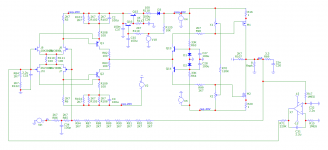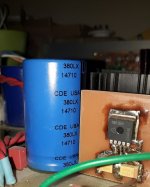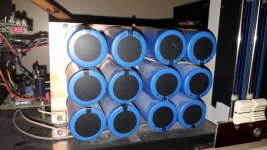I find the stacked black Ecw radial better than the redish ecw shown above.
So NickNuck, you use the bipolar ES as power bank or load decoupling as well ?
The MUSE ES is only used as a load coupling for the signal path.
The Panasonic FC are excellent but they should not be used alone in a circuitry. FMs are less good to me because their mid highs that often are fatiguing when used at power bank or smoothing...but rare cases.
Esr here is not a good information as FC and FM have very simikar esr but sounds tottaly different.
There are not better capacitor as some like to repeat it all the time, you need to mix different brands to voice well your circuitry... Designer stop the job at the circuitry design but not that difficult itterating, fatiguing because long job at mixing passive parts try to enhance their design.,,that is apity because there is a lot to do here.
I find a poor argument to choose a capacitor for its standalone paper datasheet and said quqlity in a repair job...this is not the only job for an amp or a dac to last 30 years...It is to sound the best and capacitor are a parg of it..,, I mix all the brands, sometimes same model but at a different voltage or capacitance to adjust the best sounding result in my whole hifi chain just because I can and have not the same goal than a tech that repair an amp or a brand that sell a standalone device.
I can use a Samwha with a black gate and a Nichicon Z with a Pan Fm and elswhere a Pan Fr in the sqme pcb with a decoupling near the load with qcrylic capacitors and all the devices at home sounds very well said all the hifi people that visit me.
So clearly this ranking like the best is silmic 2 or such is stupid...however they have all a typical sound and voicing in a circuitry at iso use: smoothing, coupling, decoupling, power tank, etc... Oh and I use the violett Elna and wometimes Tonorsx silk as smoothing cap in digital power supply for clock... Go figure why.
Each cap will have it's own impedance characteristics, multiply that by the design and the components connected then you have many permutations or combinations. Although a designer/builder can design and build repeatedly as close to a specification, a user experiences what is attached in front of them.
What has become very apparent to me attempting to design my own designs is the phase shift that caps make in the end it would be better without caps.
Who told about magic ? The magic would be you hear the same between two choices...and this would be a bad magic.
NickNuck, i would like to hear the last Cambridge Audio amp btw
But since it is a conversation about caps the better is when rhey are not heard or the least possible and this is a job where difrerent caps choice matters...novmagic rakking of the best always caps...silmic 2, cde380lx etc...that does not make sense as they never are each time the best choice...
NickNuck, i would like to hear the last Cambridge Audio amp btw
But since it is a conversation about caps the better is when rhey are not heard or the least possible and this is a job where difrerent caps choice matters...novmagic rakking of the best always caps...silmic 2, cde380lx etc...that does not make sense as they never are each time the best choice...
This power amp is a mixture of John Curl circuit and Peter Blomley non-switching output stage but with lateral mosfets. Anything wrong with 'lytics in that position? (Used to partially decouple emitter resistors of the complementary VAS, because I want more gain at the jfet input stage.)
I think no one uses them this way because most amps need to maximize voltage swing on the VAS transistors. In this circuit I only need current swing there (VAS gain is developed over trimpots X1 and X2 which will probably be 2K ohms).
The only issue I can see is turn-on current, which can be controlled with a large resistor before the reference in the regulator. And the open loop gain is not flat down to subsonic frequencies when using 100uF, is this a problem?
Forgive me for the repetition of 2K7 ohms throughout (local supplier only has a few values of non-magnetic resistors). Fortunately, Nichicon ES Muse 100uF 16V is available (I hope it's genuine).
Thanks,
Alex
I think no one uses them this way because most amps need to maximize voltage swing on the VAS transistors. In this circuit I only need current swing there (VAS gain is developed over trimpots X1 and X2 which will probably be 2K ohms).
The only issue I can see is turn-on current, which can be controlled with a large resistor before the reference in the regulator. And the open loop gain is not flat down to subsonic frequencies when using 100uF, is this a problem?
Forgive me for the repetition of 2K7 ohms throughout (local supplier only has a few values of non-magnetic resistors). Fortunately, Nichicon ES Muse 100uF 16V is available (I hope it's genuine).
Thanks,
Alex
Attachments
The CDE380LX in my DAC in the heater power supply and in the Hiraga 20W A class amplifier, great caps.Who told about magic ? The magic would be you hear the same between two choices...and this would be a bad magic.
NickNuck, i would like to hear the last Cambridge Audio amp btw
But since it is a conversation about caps the better is when rhey are not heard or the least possible and this is a job where difrerent caps choice matters...novmagic rakking of the best always caps...silmic 2, cde380lx etc...that does not make sense as they never are each time the best choice...
I also used them in some of my amps with laterals but higher voltage.
Attachments
They used to have the PZ,PX,PXL Pureism and Master Ta-Keh lines.
Perhaps those did not have steel leads.
True, I have a few PX & PXL that I just tried on a magnet and they don't get pulled. But the FC gets pulled.Perhaps those did not have steel leads.
Hi grunf, good cap but not systematicly the best (not each time I mean)
I did not find non copper leads to be a problem with them and often they have a better inductance with their narower leads spacing than the often praised Nichicon...
I did not find non copper leads to be a problem with them and often they have a better inductance with their narower leads spacing than the often praised Nichicon...
Last edited:
;-)
Current, circuit is not observed in components, nor in layouts - our engineers do not understand current: generally try the smallest designs.
Current, circuit is not observed in components, nor in layouts - our engineers do not understand current: generally try the smallest designs.
I have yet to see an issue with steel leads vs copper. Not at audio frequencies which I take to be up to 1 MHz. Copper bends more easily of course, so the capacitor body should be firmly mounted when using copper.
There are better uses for that money to be frank.
Besides, I have yet to see any change in circuit performance with a magnet firmly attached to a lead as long as it doesn't short something, or induce a voltage from surrounding fields. Haven't heard any difference either - just in case it is only heard and can't be measured (yeah - right!).
There are better uses for that money to be frank.
Besides, I have yet to see any change in circuit performance with a magnet firmly attached to a lead as long as it doesn't short something, or induce a voltage from surrounding fields. Haven't heard any difference either - just in case it is only heard and can't be measured (yeah - right!).
I have yet to see an issue with steel leads vs copper.
As far as I know, vacuum tube pins are an iron alloy developed to have the same coefficient of expansion as the glass envelopes.
Well, no.. Only the Kovar section that goes through the glass. They transition to other metals for inside to the electrode structures and the material for the pin. That's a three piece assembly for miniature 7 and 9 pin tubes. I don't know if they solder the Kovar wire into the pin on large base tubes or not, but the internal parts are probably different. Kovar is a more expensive alloy to use, so they limit how much they do use.
Just opened up one of the 24+ year old 15,000uF 50V Jamicon caps to see what state they were in. Surprisingly Juicy. Although they measure at ~24Mohm but can't seem to hold much of a charge:

It seems like a soaked paper + foil with wet electrolyte. The rattle was disconcerting but they probably used one canister size and stuffed the appropriate innards inside. The foil connections seem a little haphazard with no end termination just four points.
It seems like a soaked paper + foil with wet electrolyte. The rattle was disconcerting but they probably used one canister size and stuffed the appropriate innards inside. The foil connections seem a little haphazard with no end termination just four points.
Maybe we're finally learning what makes a bad (sounding) cap. 🙂
I've got a Musical Fidelity headphone amp that sounds terrible and it's full of Jamicon's.
I've got a Musical Fidelity headphone amp that sounds terrible and it's full of Jamicon's.
Maybe we're finally learning what makes a bad (sounding) cap. 🙂
I've got a Musical Fidelity headphone amp that sounds terrible and it's full of Jamicon's.
i was just looking at ebay for another MF A220.. but a dead one for the chassis and heatsink 🙂 complete internal replacement.
just preparing a few more bits - considering a few resistor changes but it’a almost done.
Difficult job: the box is a rectangular extrusion, with the front and back panels screwed on. Using it as a heatsink means big messy wiring job; MF didn't.
You're much better off buying one of these dedicated HPA boxes: it's the one I used for the JC2-HPA project.
Each design has a $ return in performance so putting lipstick on a pig with overly fancy caps is probably not going to underutilise the components.
Happy with Panasonic, CDE, Nichicon, Vishay electrolytics for main use. Rubycon and Wurth as secondary areas. The remaining electrolytics will get swapped out given the state of the 24y/o caps.
I have a MF A3.24 DAC, and the Jamicons at the outputs started leaking DC, so there was DC voltage on the output jacks. I'm eventually planning on recapping the whole thing -- when I can find the time.Maybe we're finally learning what makes a bad (sounding) cap. 🙂
I've got a Musical Fidelity headphone amp that sounds terrible and it's full of Jamicon's.
But the thing I discovered about MF is that they couldn't care less about anyone trying to repair their equipment. I managed to get someone there on the phone once (which was very difficult), and his comment was, "Well, that's an old unit." This was when it was <10 years old.
MF's attitude is that you should buy their new products, and if you want to fix an older one, you're on your own. They even use tamper-resistant screws on the chassis. When it breaks down, you're just supposed to throw it away.
Hello,
I remember Musical Fidelity as a company with some nice sounding gear but so so reliability.
Nowadays there is a thing called planned obsolescence .
Old people started telling stories a few decades ago about things being made to last and being repairable .
Today several products cannot even be opened in a logical way to check if it can be repaired. You are kind of forced to get a new one. Of course some items are that cheap that repairing would be more time/money consuming then just get a new one online.
Constructing audio gear this way will probably give you bad sound as well.
People making money with audio are no different than other manufacturers. We like to think it is a hobby so things will be different but there is just a handful of companies that will go the extra mile.
Greetings, eduard
I remember Musical Fidelity as a company with some nice sounding gear but so so reliability.
Nowadays there is a thing called planned obsolescence .
Old people started telling stories a few decades ago about things being made to last and being repairable .
Today several products cannot even be opened in a logical way to check if it can be repaired. You are kind of forced to get a new one. Of course some items are that cheap that repairing would be more time/money consuming then just get a new one online.
Constructing audio gear this way will probably give you bad sound as well.
People making money with audio are no different than other manufacturers. We like to think it is a hobby so things will be different but there is just a handful of companies that will go the extra mile.
Greetings, eduard
- Home
- Design & Build
- Parts
- Best electrolytic capacitors


